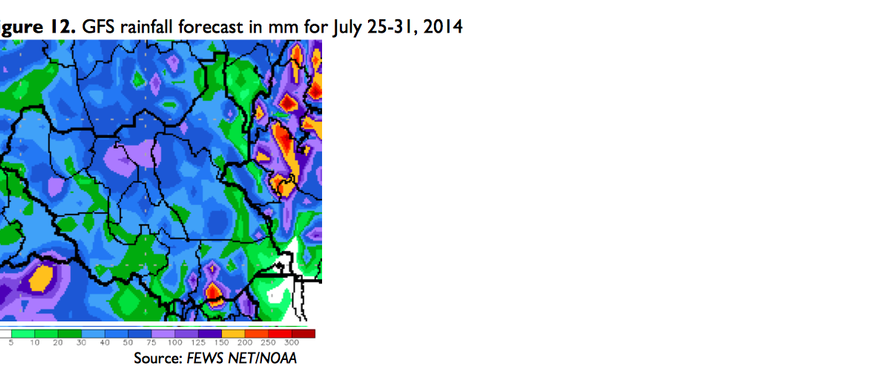Famine Early Warning Systems Network, a USAID-funded project, reported on Saturday that there will be “moderate to heavy rainfall across most of South Sudan in the coming week,” according to weather forecasts.
The rainfall affects roads and airstrips, hindering deliveries of relief supplies to conflict-displaced populations. The rains have also caused flooding at low-lying and over-crowded UN protection sites and caused flooding of crops in some areas.
According to a precipitation forecast by the Global Forecast System, up to 100 mm of rain is expected this coming week in parts of Warrap and north-central Unity State, and 50-75 mm in much of the rest of Unity (see image).
This year’s rains have been heavy. Cumulative rainfall has been ‘well above-average’ in the north of South Sudan, except in Northern Bahr al Ghazal, according to meteorological data.
A map of this shows that much of northern Unity state and parts of western Upper Nile State have seen 200-400% more rainfall than normal since 1 April.
Rains will also affect agriculture. FEWS-NET says flooding in Leer County, in Yang and Thornyor, is “likely to affect performance of germinating crops and reduce yields in these areas. Floods could further reduce harvests in these areas.”
The famine watchdog noted that in this part of Unity State the harvests were already expected to be lower than normal “because of reduced area planted.” This refers to the fact that many farmers fled from their land, owing to attacks.
“Significant reductions in area planted” are also expected in Nasir, Longechuck and Ulang counties of Upper Nile, owing to insecurity.
“Field monitoring reports roughly estimate that more than 50 percent of households may not cultivate in these areas due to displacement and insecurity,” reads the Saturday update.
Reduced planting is likewise reported in three SPLM-IO controlled counties of Jonglei State, Uror, Nyirol, and Akobo: “Preliminary estimates suggest that 20 to 40 percent of households in these counties have not yet planted.”
Related:
Situation ‘very bad’ after flooding at Bentiu protection site (25 July)




